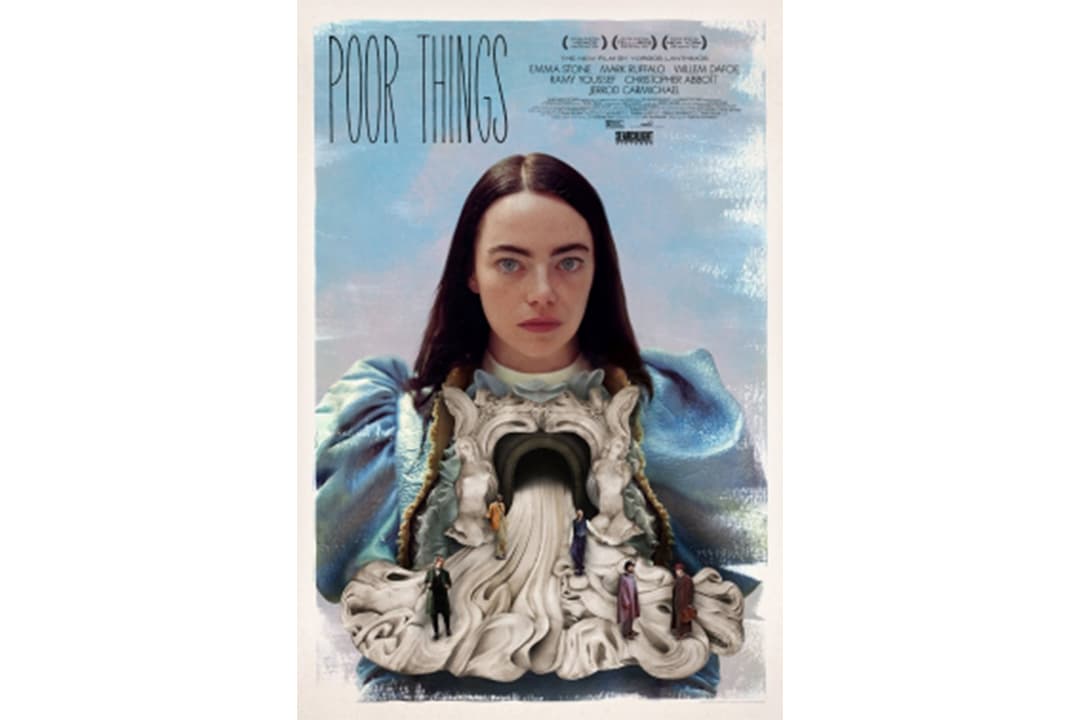Content warning: This article mentions death.
The chimera looms large over Yorgos Lanthimos’ Poor Things (2023). The word chimera, a lion-goat-dragon hybrid from Greek mythology, symbolizes the idea of a potentially freakish fusion of different creatures. Squint your eyes, viewers, and you can spot many variations of the mythical figure in the film’s central setting: the household of mad scientist Dr. Godwin Baxter (Willem Dafoe), where bizarre creations are brought to life. A menagerie of animal hybrids — a chicken pig, a bulldog goose, a duck goat — roams wild throughout the surgeon’s laboratory and home.
Poor Things’ very structure is chimeric. The film — part Frankenstein homage, part travel film — seems to delight in its incongruity. In the spirit of Godwin’s chimeric brand of reanimation, over the course of the film, the coming-of age genre itself also receives an imaginative, off-kilter rebirth.
Poor Things, a film about upbringing and development, begins ironically with the death of its protagonist. Victoria Blessington (Emma Stone) plunges off the ledge of a London bridge into the dark waters of the river below, which extinguishes her life and seemingly the life of her unborn daughter. Before long, Victoria’s corpse is plucked out of the river by Godwin, who has the novel idea to insert the child’s brain into Victoria’s body. A macabre switcheroo ensues; Victoria Blessington becomes Bella Baxter.
The coming-of-age story is reinvented in a fashion I found refreshing as Lanthimos unearths new trajectories of this genre. Uniquely, Bella’s birth is not the beginning of her story, and Victoria’s presence continuously haunts the narrative. As such, this is not a coming-of-age film that just progresses linearly forward but also backward to reconcile with Bella’s past life.
Lanthimos also reconfigures the typical timeline of the coming-of-age film by having Bella be ‘born’ physically as an adult. While she does not visibly age throughout the movie, within the film’s confined timeframe she nevertheless traverses many pivotal life stages, from infancy to adulthood — often non-sequentially. These stages overlap for Bella; she is still learning how to speak and understand basic social cues while experiencing a sexual awakening and confronting societal injustices.
Viewers familiar with Lanthimos’ body of work will find certain parts of Poor Things uncannily recognizable. Following in the footsteps of Dogtooth (2009) and the Lanthimos-produced Attenberg (2010), Poor Things once more foregrounds repressed adults who yearn to break free from the confinement of their households and parents. This tension between restriction and freedom and Bella’s use of language most directly recalls Dogtooth, wherein sadistic parents teach their sheltered adult children a disjointed vocabulary. Bella’s education and wordplay bring about some of Poor Things’ most comedic moments — this very well may be Lanthimos’ most overtly funny film. Bella delights in her discoveries of carnal pleasures — she calls sex “furious jumping” — which culminates in the wry observation: “Why do people not just do this all the time?”
Bella’s journey of self-discovery is cleverly aligned with a much more literal expedition. Bella departs Godwin’s workshop for a global trot around the world; this leads to the infusion of elements of the adventure film and the road movie genre into Poor Things’ DNA.
My favourite stylistic element is the dazzling, dreamlike black and white title cards that chart Bella’s journey, from London to Lisbon to Paris. These tableaux feel as if they are not being used as superfluous decoration but as inventive benchmarks to mark destinations along Bella’s journey, which coincide with important periods of development for Bella’s evolution, much like how sketched lines on kitchen door frames mark the growing heights of children.
Poor Things shines a light on Lanthimos’ own filmmaking journey. The film is his fourth feature made in English with Hollywood actors, after cutting his teeth on his early films as part of the “Greek Weird Wave.” However, it feels as if the director has finally arrived in mainstream filmmaking — for better or worse.
Along with the more familiar components of his work, Lanthimos introduces new stylistic elements that may divide long-term fans. Gone are the muted colour palettes and minimalistic art direction that dominate films such as Dogtooth and The Lobster (2015). Now, this starkness is replaced by an ornate visual style that seems to pull from various eclectic sources, from Tim Burton’s films to Antoni Gaudi’s architecture.
I was in disbelief at the depths of Bella’s marvellous wardrobe created by costume designer Holly Waddington — ruffled dresses, a pastel translucent coat, a puffy blue jacket and a yellow shorts ensemble. Likewise, the deadpan performances that conjured the cruel tone so prevalent in Lanthimos’ early works have also been supplanted by the exaggerated and whimsical performances by Emma Stone and Mark Ruffalo.
By the end of Poor Things, I was caught off guard by how moved I was by the film’s tender story. Due to Bella’s lack of physical changes as she grows up, her evolution feels gradual and subtle. As she evolved from infantile babbling to an unapologetic quest for enlightenment and independence, I began to relate to Bella without knowing it, like I was growing alongside her.
Some may find that, in Lanthimos’ relocation from the Greek film industry to larger budget English language films, some of his bite and edge have been excised. However, in its place, in this quirky potpourri, Lanthimos sprinkles in a surprising ingredient: sincerity.



No comments to display.